Astronomers discover Mars-sized exoplanet where a year is eight hours and the ground is molten iron
‘This brings research one step forward in the search for a “second Earth”,’ says expert

Astronomers have found a distant exoplanet where the surface could be made of molten iron.
The planet, classified as GJ 367b, is located 31 light years away from the Earth and has a diameter of just over 9,000km, making it roughly the size of Mars.
"From the precise determination of its radius and mass, GJ 367b is classified as a rocky planet," Kristine Lam of the German Aerospace Centre said.
"It seems to have similarities to Mercury. This places it among the sub-Earth sized terrestrial planets and brings research one step forward in the search for a ‘second Earth’."
Its year lasts under eight hours, making it a part of the ‘ultra-short period’ (USP) group of planets, which orbit their star in less than one Earth day.
Since the planet is so close to the star its surface temperature could reach 1,500C – soaking up more than 500 times the radiation the Earth does.
"We already know a few of these [USP planets] but their origins are currently unknown," said Dr Lam. "By measuring the precise fundamental properties of the USP planet, we can get a glimpse of the system’s formation and evolution history."
Researchers were able to determine the radius and mass of the planet with a high degree of precision measuring its radial velocity – the wobble as it moves towards and away from the Earth – which also gave them more information about its inner structure.
"The high density indicates the planet is dominated by an iron core," said the German Aerospace Centre's Szilárd Csizmadia. "These properties are similar to those of Mercury, with its disproportionately large iron and nickel core that differentiates it from other terrestrial bodies in the Solar System."
GJ 367b is located around a red dwarf star approximately half the size of the sun. Their comparative cool temperature makes spotting planets around them easier to find, and they are some of the most common objects in our galaxy.
Join our commenting forum
Join thought-provoking conversations, follow other Independent readers and see their replies
Comments
Bookmark popover
Removed from bookmarks